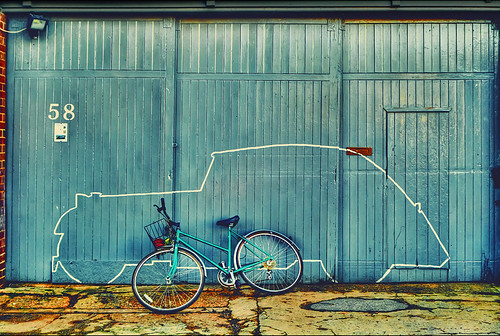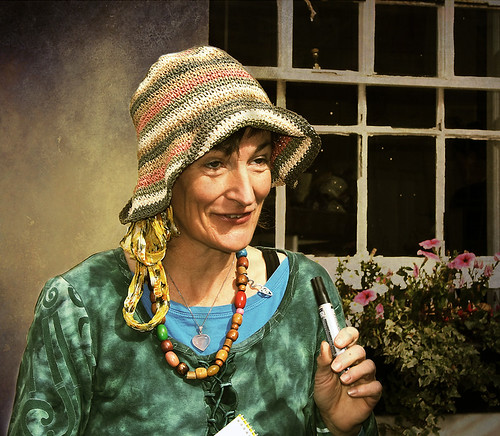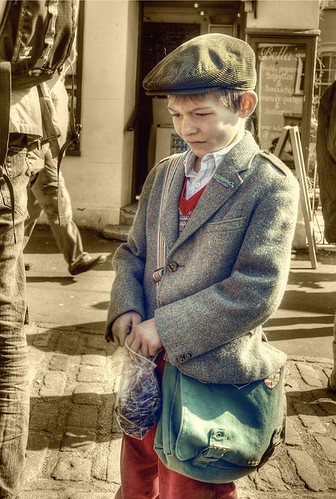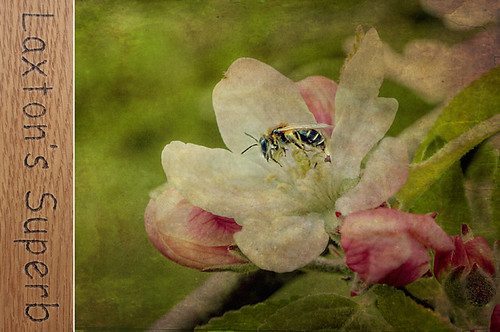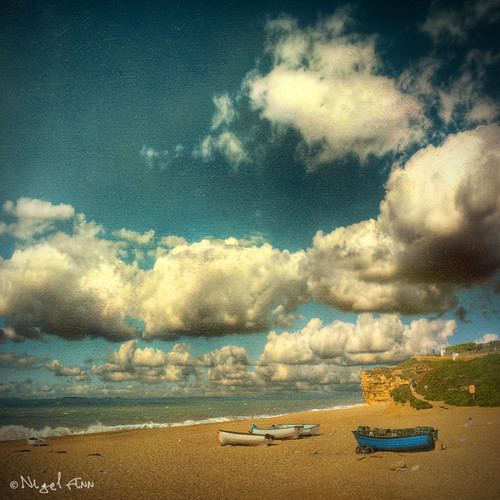Every once in a while I get the urge to dig out some paints, or a few sticks of pastels, and set about reminding myself why I am a photographer. I don't really remember much about painting or "colouring-in" from junior school (aged 5-10) so it probably wasn't making much of an impression on me at that age, when it might have been grabbing the attention of other future Van Goghs or Kandinskys or Pollocks. I do remember making Easter chicks out of wool and cardboard discs, though only because there was clearly magic involved somewhere between the raw materials and the end result. I'm sure I wasn't in control of that little experiment at any time, but somehow it worked! And from secondary school onwards (11+) that's very much the way I have felt about those gifted people who make art from paint or pastels, chalk or charcoal or pens and pencils - there is magic going on somewhere, and I was absent from school the day the spells were taught.
From age 9 onwards, however, I was grabbed by the world of cameras and initially film. I could see something attractive or interesting in some way, I'd press a button, and a few days and a little pocket money later, I had my own miniature, 2D version in my hand. No mess, no inexplicable communication breakdown between my mind and my hand, and no feelings of being a complete and utter creative failure.
I went on to start the school's first ever photography club and built its first ever darkroom, and to complete the hat-trick of "things you weren't supposed to do at school" failed my final exams and went to college to study Media Arts & Technology instead of going to Oxford or Cambridge to read Latin and Classic Hungarian Literature of the 17th Century like all the other good little boys. (I did eventually find my way into University and out again with the appropriate scroll and silly hat, and on the way discovered many, many things I never want to do, but it was fun and I'd do it all again at the drop of that silly hat, but it had nothing to do with my real passion, photography.Anyway, I digress. What I really wanted to say was that throughout all these little adventures and different directions I have always had that silent wish in the back of my mind to be able to produce a painting. With age and experience I realise that a painting doesn't have to look like one of the grand master's to be art, and that I might be able to get away with a limited ability as long as my intention and message was strong, but I also realise that I'm not too concerned about "spreading a message" or "challenging beliefs" on canvas. Purely and simply, I actually do want to produce something that looks like it was painted by a master, but is relevant to my life, and the things I see. And that is where digital photography raises its hand and shouts "Me! Me! Me! I can do that!" from the back of the classroom. I remember the first time I got a copy of Photoshop Elements (it didn't even have a version number in those days) and saw with no little excitement things called "Paint Daubs", "Rough Pastels" and "Watercolor". I also remember, 5 minutes later, the feelings of total disappointment to discover that they didn't match up to my hopes at all, and in fact it was sometimes hard to tell afterwards which filter I had used.
A couple of years later, when I got a copy of Photoshop CS2, I half assumed, half hoped that there would have been big strides in the realism of these features, but sadly no.
A few actions have also made their way through to my desktop, most notably a set by Mike Finn - I think I was drawn by the name rather than the action, if I'm perfectly honest, but it still produces some acceptable results, though still not meeting my needs.
Around about the same time, there were a number of photographers on Flickr who were experimenting with layered textures to various degrees of success. This was a completely different approach to a common theme, and was one of those huge advances that comes about from time to time that totally transformed the world of photography, and it is still progressing a-pace now. The thought of taking a perfectly lovely photograph and slapping over the top of it a photograph of mud or cracked and broken concrete seemed ridiculous as an idea, but with a little experimentation of blending styles and contrasts the end result somehow looked as if it had been crafted with a thickly oiled brush on a heavy, ancient canvas.
I'll talk a lot more about my journey through texture work in future blogs, I'm sure, but before I lose your interest, and forget the point of THIS blog, I would like to tell you of a new landmark in digital photographic manipulation. At least I think so. I discovered it by chance, mentioned on a Red Bubble site by a talented photographer, Elaine Teague whose work I have been admiring for a while now, and it's called Dynamic Auto Painter.
I love it!
All of the photos in this blog entry have been produced with a very rudimentary understanding of the program. I have only downloaded the free version (it's not hard to get around the watermark problem!) and have probably used it for less than 2 hours so far due to some hectic photography jobs I've been working on this last week, but I'm just loving every minute of it. I think it uses the principle of the Art History Brush available on Photoshop which I find quite tricky to get to grips with, in that while it seems to be painting step by step onto a canvas, in reality it is revealing step by step a number of images layered underneath. One of the truly great things about D.A.P. is that you are not left waiting and waiting, staring at an unmoving screen, watching an egg timer occasionally revolve, before finally being presented with either a rubbish image that just gets you angry for having wasted your time, or telling you that it can't perform this operation due to total memory failure, or something. No, none of that. With D.A.P. you get to see your painting evolve at every step, at whatever speed and detail you choose. You can use your mouse to concentrate the processing on specific areas if you wish, and stop the whole procedure at any time. Like real life, if you set the mode to "continuous" the painting will never stop.There are so many preset styles to choose from including wax crayons, watercolour, oils etc and variable degrees of impressionism, surrealism and palettes to mess about with. I'll be honest, I'm having as much fun watching it do it's stuff as I am with the finished result. It's got that magic that always had me spellbound as a child, and still does as a grown-up, and I can see it happening on my own photos. What fun!
I don't know how much longer this love affair will last, and obviously I'd love to find out exactly how it is doing it so that I can do it all by myself, but for the moment I'm thoroughly enjoying messing about, without any of the mess. This, coupled with a liberal dose of cracked concrete texture layer and I fully expect to be exhibiting in Tate Modern this time next year.
Now, about those wooly chicks.....
My Digital Canvas
Labels:
art,
digital,
dynamic,
editing,
effect,
manipulation,
paint,
photography,
photoshop,
processing
Some Time In Lyme
I've been living in this little corner of England for over three years now, but only visited the nearby town of Lyme Regis a handful of times. Worse still, I've only ever really walked along the promenade and round the harbour.
It's quite a pretty harbour and town centre, but much of this is lost under the stampede of summer tourists. With this in mind, last month I set off to explore the back streets, the paths less travelled. In the end I'm sure I only just scratched under the surface, but I was so pleasantly surprised by the curious little corners, the meandering and quirky walkways and the hickledy-pickledy houses and cottages that I'll definitely return for another dose.
One of the first of my little discoveries was this old post box mounted into the wall. On the wall above was a little blue plaque - I'm a sucker for these and often risk life and limb crossing busy roads just for that little thrill of knowing I might be walking in the footsteps of historic giants. Sadly this time there was no mention that a famous person was born here, or died near here, or even just paused for thought somewhere close by, but it did tell me that this was one of the oldest post boxes in the country dating back at least as far as 1799 - long before we started liberally adorning them in bright, shiny, red paint. In fact, at that time it was more usual for people to gather in the street, or at least send their children into the street waiting for the daily, or even weekly mail coach. And today we complain if our broadband speed fails to deliver an email within 20 seconds.
It was a pity that the yellow lines ran along this road, making it just that bit harder to imagine a mail coach bouncing along this lane, although I have since read that this is in fact the oldest street in the whole town. Now bearing in mind that the town was considered so important that King Edward I granted it a royal charter as far back as 1284, and indeed it was mentioned in the Domesday Book of 1086, that must make this little lane easily over a thousand years old.
Clearly the designs of the houses did not date back anywhere near that far, but there was still a marvellous uniqueness to each and every one, a trait so often lost in modern towns and cities with their anonymous plate glass windows, and repetitive greyness as far as the eye can see. Here in Lyme it was as if the whole town had got together in the town hall one evening and decided between them who was to have which colour paint to brighten their house.
Standing in a little gated garden I couldn't decide whether the widest variety of colour was among the flowers or indeed the buildings surrounding them. And it wasn't just the colours that changed with every step, but the styles of building and their purpose.
Along a row of what initially appeared to be traditional Georgian houses, there would randomly appear a bakery, or an art gallery and with very little announcement a museum of fossils boldly named Dinosaurland! Lyme Regis, for those who have not visited, is another town along Dorset's Jurassic Coast, 95 miles of rocks and cliffs afforded World Heritage status, alongside such greats as The Grand Canyon. Almost every stride along the beaches, particularly nearer Lyme, you are likely to be walking on fossils of sea creatures 150-200 million years old. Many will be no larger than a coin, but occasionally true giants are discovered that previously we might only have guessed at in films.
Anyway, as tempting as it was to dart into the museum, I remained true to my promise and strolled on through the back streets of Lyme.
It's only now, when I look up on Google Maps the names of the streets, that I realise just how little of this remarkable town I wandered around. I may have just been lucky finding the only hidden corner of town to have so many diverse little charms, but I somehow doubt it.
Around another corner, at the junction of Coombe Street and Sherbourne Lane if you happen to be in the area, I discovered one of those more traditional, scarlet post boxes tucked neatly into the wall of a bridge.
I've no doubt the bridge is considerably the older, but it was pleasing to see that the addition of the more modern post box did nothing to detract from beauty of the old stone.
And there, from that bridge, I found the most unexpected sight of the day, and it wasn't the little family of ducklings frantically chasing around after their mum. Rather it was a scene that could easily have been taken from a hillside village in Provence. A rocky, drying river flowing under the road and beside tall, colourfully-shuttered houses, weaving its quiet way, almost unnoticed, through the back streets and houses of Lyme Regis. But running parallel to this river, and about 4 metres higher, was another little stream. It ran almost touching the front doors of the houses lined along this miniature valley. Indeed, each house had their own little stone bridge crossing this small stream to their front doors from the pedestrian path that divided the rivers. It was utterly charming in so many ways, but not least of which because I was almost the only person there to enjoy it.
I'm sure there is plenty more to explore of the town, but for now I'll leave that for the summer tourists and the kids who will shortly be running free from their schools, but already I'm determined and eagerly looking forward to another day of discovery in the autumn.
In my next blog, I'll talk about the photography and digital painting styles I've used here.
It's quite a pretty harbour and town centre, but much of this is lost under the stampede of summer tourists. With this in mind, last month I set off to explore the back streets, the paths less travelled. In the end I'm sure I only just scratched under the surface, but I was so pleasantly surprised by the curious little corners, the meandering and quirky walkways and the hickledy-pickledy houses and cottages that I'll definitely return for another dose.
One of the first of my little discoveries was this old post box mounted into the wall. On the wall above was a little blue plaque - I'm a sucker for these and often risk life and limb crossing busy roads just for that little thrill of knowing I might be walking in the footsteps of historic giants. Sadly this time there was no mention that a famous person was born here, or died near here, or even just paused for thought somewhere close by, but it did tell me that this was one of the oldest post boxes in the country dating back at least as far as 1799 - long before we started liberally adorning them in bright, shiny, red paint. In fact, at that time it was more usual for people to gather in the street, or at least send their children into the street waiting for the daily, or even weekly mail coach. And today we complain if our broadband speed fails to deliver an email within 20 seconds.
It was a pity that the yellow lines ran along this road, making it just that bit harder to imagine a mail coach bouncing along this lane, although I have since read that this is in fact the oldest street in the whole town. Now bearing in mind that the town was considered so important that King Edward I granted it a royal charter as far back as 1284, and indeed it was mentioned in the Domesday Book of 1086, that must make this little lane easily over a thousand years old.
Clearly the designs of the houses did not date back anywhere near that far, but there was still a marvellous uniqueness to each and every one, a trait so often lost in modern towns and cities with their anonymous plate glass windows, and repetitive greyness as far as the eye can see. Here in Lyme it was as if the whole town had got together in the town hall one evening and decided between them who was to have which colour paint to brighten their house.
Standing in a little gated garden I couldn't decide whether the widest variety of colour was among the flowers or indeed the buildings surrounding them. And it wasn't just the colours that changed with every step, but the styles of building and their purpose.
Along a row of what initially appeared to be traditional Georgian houses, there would randomly appear a bakery, or an art gallery and with very little announcement a museum of fossils boldly named Dinosaurland! Lyme Regis, for those who have not visited, is another town along Dorset's Jurassic Coast, 95 miles of rocks and cliffs afforded World Heritage status, alongside such greats as The Grand Canyon. Almost every stride along the beaches, particularly nearer Lyme, you are likely to be walking on fossils of sea creatures 150-200 million years old. Many will be no larger than a coin, but occasionally true giants are discovered that previously we might only have guessed at in films.
Anyway, as tempting as it was to dart into the museum, I remained true to my promise and strolled on through the back streets of Lyme.
It's only now, when I look up on Google Maps the names of the streets, that I realise just how little of this remarkable town I wandered around. I may have just been lucky finding the only hidden corner of town to have so many diverse little charms, but I somehow doubt it.
Around another corner, at the junction of Coombe Street and Sherbourne Lane if you happen to be in the area, I discovered one of those more traditional, scarlet post boxes tucked neatly into the wall of a bridge.
I've no doubt the bridge is considerably the older, but it was pleasing to see that the addition of the more modern post box did nothing to detract from beauty of the old stone.
And there, from that bridge, I found the most unexpected sight of the day, and it wasn't the little family of ducklings frantically chasing around after their mum. Rather it was a scene that could easily have been taken from a hillside village in Provence. A rocky, drying river flowing under the road and beside tall, colourfully-shuttered houses, weaving its quiet way, almost unnoticed, through the back streets and houses of Lyme Regis. But running parallel to this river, and about 4 metres higher, was another little stream. It ran almost touching the front doors of the houses lined along this miniature valley. Indeed, each house had their own little stone bridge crossing this small stream to their front doors from the pedestrian path that divided the rivers. It was utterly charming in so many ways, but not least of which because I was almost the only person there to enjoy it.
I'm sure there is plenty more to explore of the town, but for now I'll leave that for the summer tourists and the kids who will shortly be running free from their schools, but already I'm determined and eagerly looking forward to another day of discovery in the autumn.
In my next blog, I'll talk about the photography and digital painting styles I've used here.
Labels:
dorset,
england,
explore,
history,
lyme regis,
photography,
town,
travel
Location:
Lyme Regis, Dorset, UK
Subscribe to:
Posts (Atom)
About Me
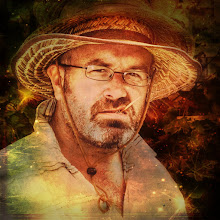
- Nigel Finn
- Comic, Raconteur, Artist, Philanthropist - Just some of the words I've heard recently. I've also heard "laminate", "Isolation", "antelope" and "rumbunctious."
Labels
band
(1)
bridport
(2)
entertainment
(1)
instruments
(1)
military
(1)
music
(2)
photography
(5)
street
(2)
Followers
Favorite links
My Blog List
Powered by Blogger.
